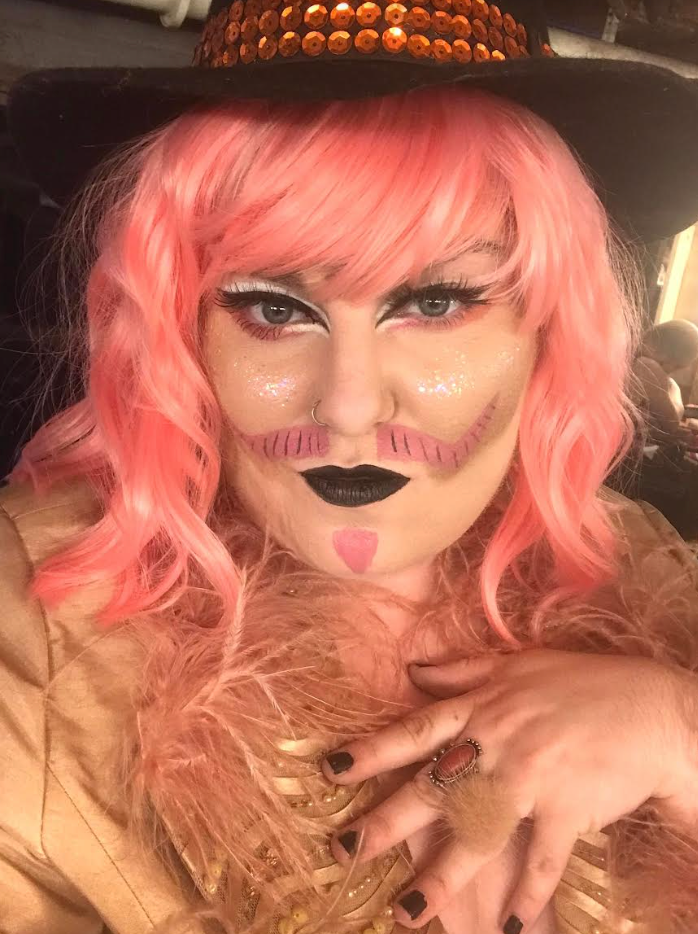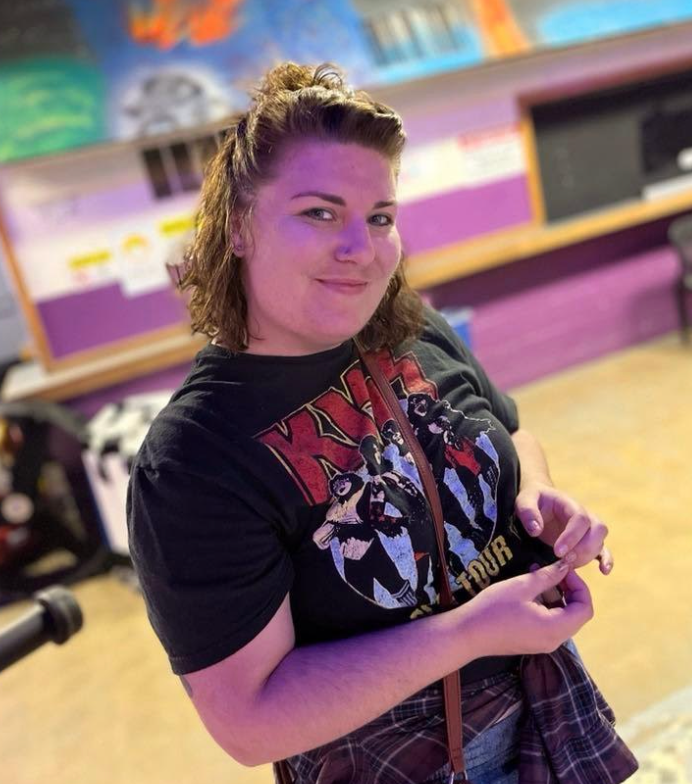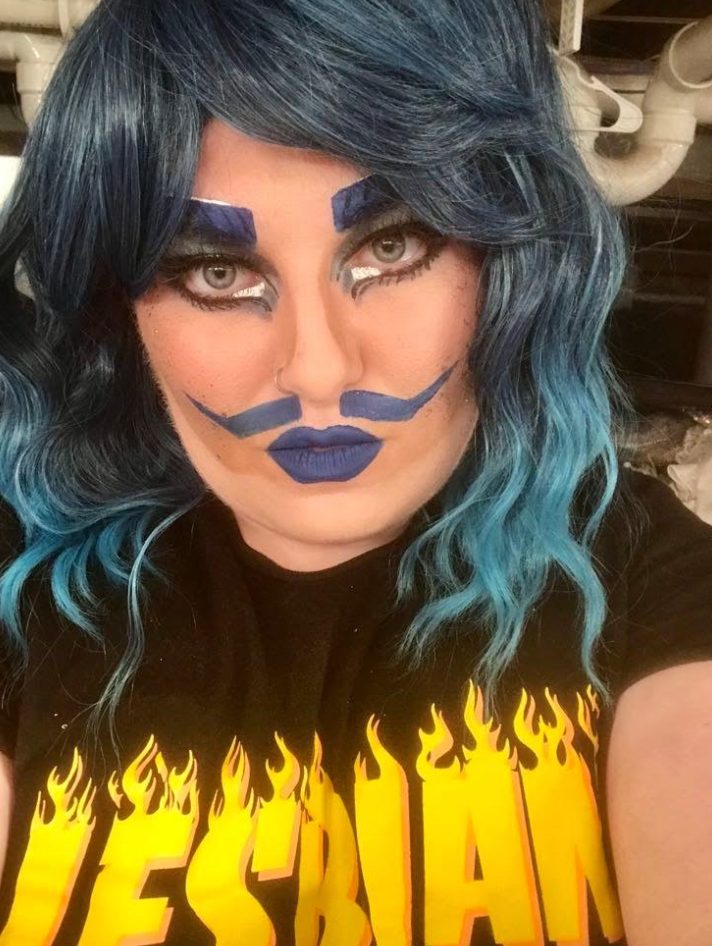
Until I was 19 and left my hometown in rural Michigan for the first time, I was only vaguely aware that there was such a thing as drag. Not a single student in my high school was out. We never used the word “gay” as anything but a slur. The closest anyone ever came to discussing queerness was government class, where we learned about a landmark Supreme Court ruling from 1986 that said states could outlaw homosexual acts. When I asked my teacher what exactly had been criminalized, he plucked a dictionary from his bookshelf and threw it at me.
“Look up the word ‘sodomy,’” he told me.
I saw my first drag show the summer after my freshman year of college, while I was in Houston for an internship. At the time, I was dating a woman but not yet using the word “gay” to describe myself. I was battling self-hatred that had been exacerbated by my strict Catholic upbringing. My home life was unsafe and unstable, and my only coping mechanisms were excessive exercise and a severe eating disorder. A book for LGBTQ youths that I snuck out of the public library promised it would get better. But when I looked around, I didn’t see any of the happy, successful queer people highlighted within its pages. I barely saw any queer people at all.
The gay bar I found in Houston was a hole in the wall in a strip mall. I walked in, sore and exhausted from a recent workout, with only $3 in cash. The drag show had just started, and while I was mesmerized by the queens with their big hair and rhinestones, I was mostly enamored with the single drag king. He was small and wiry with a bolo tie, and he lip-synced to James Brown’s “It’s a Man’s Man’s Man’s World.” Watching him, everything in me caught fire. I had to remind myself to breathe. I wasn’t sure what I was seeing, but what came to mind was power.
It’s a kind of miracle that I encountered a king at my first drag show, given that queens dominate the contemporary drag scene. While male impersonation has a long and storied history, from ancient Greece to performances of Shakespeare plays, I didn’t know that people who were assigned female at birth could do drag.
In my Google searches, I learned about Stormé DeLarverie, a butch lesbian referred to as a male impersonator by scholars, and how she was at the center of the inciting incident of the Stonewall uprising. I learned that women played some male characters in Chinese opera as far back as the seventh century. I discovered Kristine Bellaluna, whose drag king career as Landon Cider led to her being crowned the “world’s next drag supermonster” on TV’s “The Boulet Brothers’ Dragula” in 2019. But when I was 19 in Houston, all I knew was that I wanted in on what I saw with that drag king in his glitter beard and bolo tie. I wanted a taste of that power.
It took almost a decade after seeing that show to commit to drag full time. During those years, I came out of the closet, again and again. I started weekly trauma therapy. I moved to St. Louis with my girlfriend, and we got married. I also discovered roller derby — and a team of queer weirdos who became my chosen family.
But in early 2022, there was still something missing. At 27, I was struggling with bouts of mania and the side effects of medication that was supposed to be stabilizing me. I was blocked creatively, and I longed for another outlet to express myself and celebrate queerness. So, I started reaching out to drag kings on social media.

One king I discovered was a transgender man who happened to teach about drag kinging, and he extended an invitation for me to join his class virtually. Over the next eight weeks, I learned how to bind my breasts with athletic tape. I learned about dressing room etiquette, taking tips, and how to watch out for roofies. I learned how to perform masculinity, which involved a complete overhaul of the conditioning I’d experienced to take up as little space as possible.
After the class ended, I created my alter ego, Fender Bender (a play on “gender-bender”), originating as a blue-collar mechanic loosely based upon my father. For my first performance, I glued rhinestones to a navy blue jumpsuit and lip-synced to a song called “Workin’ for a Livin’” by Huey Lewis and the News. The critiques I got amounted to “We’re glad you’re here, but you have a lot to learn.”
Every week after that July show, I performed two songs with original concepts and looks. I hunted for secondhand costumes all over St. Louis that I could alter with a hot glue gun, faux fur and plastic gems. The host of the show, Teonia, implored me to dig deeper. “You have to sing it like you wrote and recorded it,” she told me. “You need to feel it in your bones.”
In trying to interpret what she meant, I began pouring all my energy into drag. I performed songs about mania — “Don’t Stop Me Now” by Queen and “Crazy” by Gnarls Barkley ― in which I revealed that I was wearing a hospital gown under my raincoat. I never placed in the top three, but I did start connecting deeply with the more seasoned performers. One of them, a cisgender woman performing as drag queen Rocky St. Moore, became my closest friend.
It’s hard to know exactly when drag started changing everything. Maybe it was when I realized Rocky was the first person I would text when I had a new idea. Maybe it was when I signed up for dance classes to improve my stage presence — my first form of physical movement in which the purpose was not managing my weight or winning an athletic competition. Maybe it was when I carved out time for my own art again or started designing elaborate, sculpturelike costumes. Or maybe when my wife got me a sewing machine, or when I started coming into my own as a sexual being. Queer love — especially queer sex — was never something I wanted to forefront in my life, and then I found myself performing “Good Vibrations” by the Beach Boys with a giant purple vibrator.
Other people took notice of the changes occurring in me. Perhaps the most obvious were the cashiers at thrift shops and craft supply stores who had to tolerate me paying for everything with $1 bills.
“Good night at the club?” one man asked me.
“I’m not a stripper,” I deadpanned.
“Queer love — especially queer sex — was never something I wanted to forefront in my life, and then I found myself performing 'Good Vibrations' by the Beach Boys with a giant purple vibrator.”
Rocky wasn’t the only person in the drag scene who changed my perspective on queer desire and all the different ways to be out and visible. I met a queen who was also dealing with bipolar disorder, and she helped ground me during a particularly difficult manic episode. I met a Southern teenage queen who inspired me by fighting to claim her identity as a trans woman off the stage. I also met a fierce competitor who urged me to take my art seriously.
My breakthrough performance happened on a cold night in January. I decided that I wanted to use my act to comment on the way queer culture pedestalizes and exalts “RuPaul’s Drag Race.” So, I parodied an infamous moment on the show when a queen attempted to release live butterflies but they were either asleep or dead, making the entire act a dramatic failure.
I wore a Goodwill suit jacket that I hand-painted. I excavated the song “Butterfly” by Crazy Town from the ’90s and designed my own butterfly pasties. I dropped the invisible partition between me and the audience. As I danced on the stage, Teonia started shouting encouragements into the microphone. “Make me feel it now, Fender,” she said. “Here we go!” I danced harder. I unclasped my bra, which was filled with paper butterflies, and let them rain onto the stage.
I won the whole competition that night. After the show, a scout approached me from a local talent agency. He asked if he could represent me and cast me in a drag extravaganza event that would attract an audience of hundreds.
It’s sometimes hard to fathom all the ways I’ve evolved since I was a scared teen with such a limited view of sexuality and gender that I thought wearing dresses would deflect any suspicion that I was gay. Drag allows me to explore and discover parts of myself — especially masculine parts — that I had tried to deny, ignore and eradicate. I do not identify as male, but onstage I can embody qualities like machismo and self-assuredness that many men consider their birthright.
The growth I’ve undergone was never more obvious than when I was recently invited to a Zoom meeting with my old high school’s queer Alliance Club. The group hadn’t existed when I was a student.
“It’s different here now,” said teens involved with the club. “It’s not perfect. There are still a lot of bigots. We’re still on edge. But it’s not as bad as it was before.”
What scares me, I told them, are the ways in which lawmakers have attempted to reproduce the situation in which I was raised. I didn’t “say gay” until college, and by then the damage was so profound that I considered ending my own life. I had no models of openly queer people who were just existing in the world. Even my lesbian aunt in Colorado felt worlds away, and my parents taught me to refer to her partner as her “friend.”
It dawned on me, while speaking to the high schoolers in my hometown, that I had become the role model I wish I’d had.

Recently, someone called my home bar and said he was planning to shoot up the place. He called himself “the Joker.” The following evening, I did my makeup at home rather than in the dressing room like I usually do. I wanted to cut down on the amount of time I had to be at the bar in case that anonymous caller decided to follow through on his promise.
In response to the death threat, my friend Rocky said, “All we want to do is exist.” And existing, in this time and space, is itself a radical act. Drag is increasingly under attack — not only from armed right-wing individuals and groups like the Proud Boys, but also from politicians who want to restrict it. Tennessee has already done so. Other states could soon follow.
Drag is an art form that is also an act of resistance, a celebration of all we’ve experienced as queer people. It is not about grooming children or any of the other offensive and untrue things that are said to erase queer people in this country. It’s a way to harness our power and to showcase our creativity and artistry in a space that ought to be safe and legal.
I wish I could tell that drag king with the bolo tie how he changed the life of a closeted, suicidal teenager. I wish we could talk about how to fight the dangerous legislation that would criminalize performances by “male or female impersonators” in public spaces and make it illegal to discuss gender or sexuality with students.
I also wish there was a way to know the full impact I’m having on other people I encounter, both onstage and in my regular life. But maybe not knowing is part of the beauty. Maybe I just have to trust, and continue stepping into the spotlight.
Gabe Montesanti is the author of a memoir about roller derby, “Brace for Impact,” and is currently at work on an illustrated memoir about drag. Find her on Instagram at @gabemontesantiauthor.
If you or someone you know needs help, dial 988 or call 1-800-273-8255 for the National Suicide Prevention Lifeline. You can also get support via text by visiting suicidepreventionlifeline.org/chat. Outside of the U.S., please visit the International Association for Suicide Prevention for a database of resources.
If you’re struggling with an eating disorder, call the National Eating Disorder Association hotline at 1-800-931-2237.
For mental health or substance use disorder issues, call 800-662-HELP (4357) in the U.S. for the SAMHSA National Helpline.
Do you have a compelling personal story you’d like to see published on HuffPost? Find out what we’re looking for here and send us a pitch.
